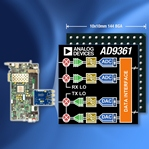 Analog Devices has launched an RF solution for software defined radio (SDR) applications that supports programmable radio applications operating over a wide range of modulation schemes and network specifications such as defence electronics, instrumentation equipment and communications infrastructure. The new AD9361 RF Agile Transceiver offers a combination of performance, high integration, wideband operation and flexibility.
Analog Devices has launched an RF solution for software defined radio (SDR) applications that supports programmable radio applications operating over a wide range of modulation schemes and network specifications such as defence electronics, instrumentation equipment and communications infrastructure. The new AD9361 RF Agile Transceiver offers a combination of performance, high integration, wideband operation and flexibility.
The AD9361 is supported by a wide range of design resources helping to speed time to market including a software design kit and FPGA mezzanine card (FMC) to rapidly develop software defined radio solutions.
“The AD9361 Agile Transceiver is a complete RF transceiver solution on a single chip,” said Matt Ettus, President of Ettus Research, a National Instruments Company. “We were able to combine the AD9361 with a Xilinx Spartan-6 FPGA, USB 3.0 interface and comprehensive software support, to create an easy-to-use and very flexible software-defined radio solution.”
The AD-FMCOMMS2-EBZ-FMC board enables designers to prototype rapidly and it supports multiple communications protocols, including most licensed and unlicensed bands.
“The programming flexibility and configurability of the AD9361 combined with the flexibility of a low power software configurable radio and its small footprint enables new levels of design versatility,” said Sam Fuller, chief technology officer, Analog Devices. “This technology advancement is supported by an equally advanced range of customer ecosystem design support features to minimise time-to-market constraints and reduce project risk.”
Operating over a frequency range of 70 MHz to 6 GHz, the AD9361 is a complete radio design that combines multiple functions in a single chip. The RF agile transceivers integrate an RF front end, flexible mixed-signal baseband section, frequency synthesisers, two analogue-to-digital converters and two direct conversion receivers to simplify design and reduce bill of material cost. The AD9361 supports channel bandwidth from less than 200 kHz to 56 MHz, and is highly programmable, offering the widest dynamic range available in the market today.
Two independent direct conversion receivers have a state-of-the-art noise figure and linearity. Each receive subsystem includes independent automatic gain control, dc offset correction, quadrature correction, and digital filtering, eliminating the need for these functions in the digital baseband. The AD9361 also has flexible manual gain modes that can be externally controlled.
Two high-dynamic-range A/D converters per channel digitize the received I and Q signals and pass them through configurable decimation filters and 128-tap FIR filters to produce a 12-bit output signal at the appropriate sample rate. The transmitters use a direct conversion architecture that achieves high modulation accuracy with ultra-low noise.
 CIE Components in Electronics
CIE Components in Electronics



